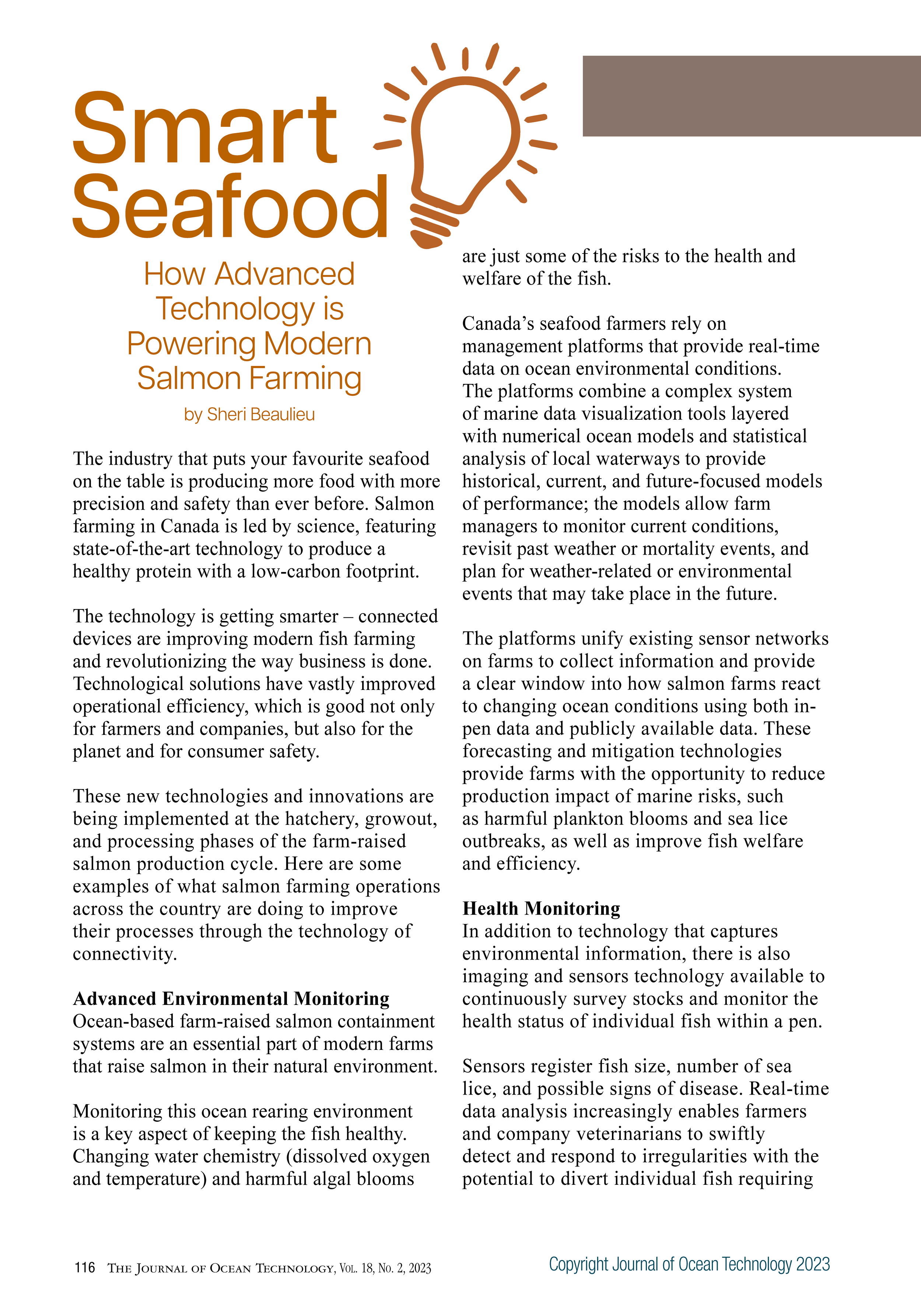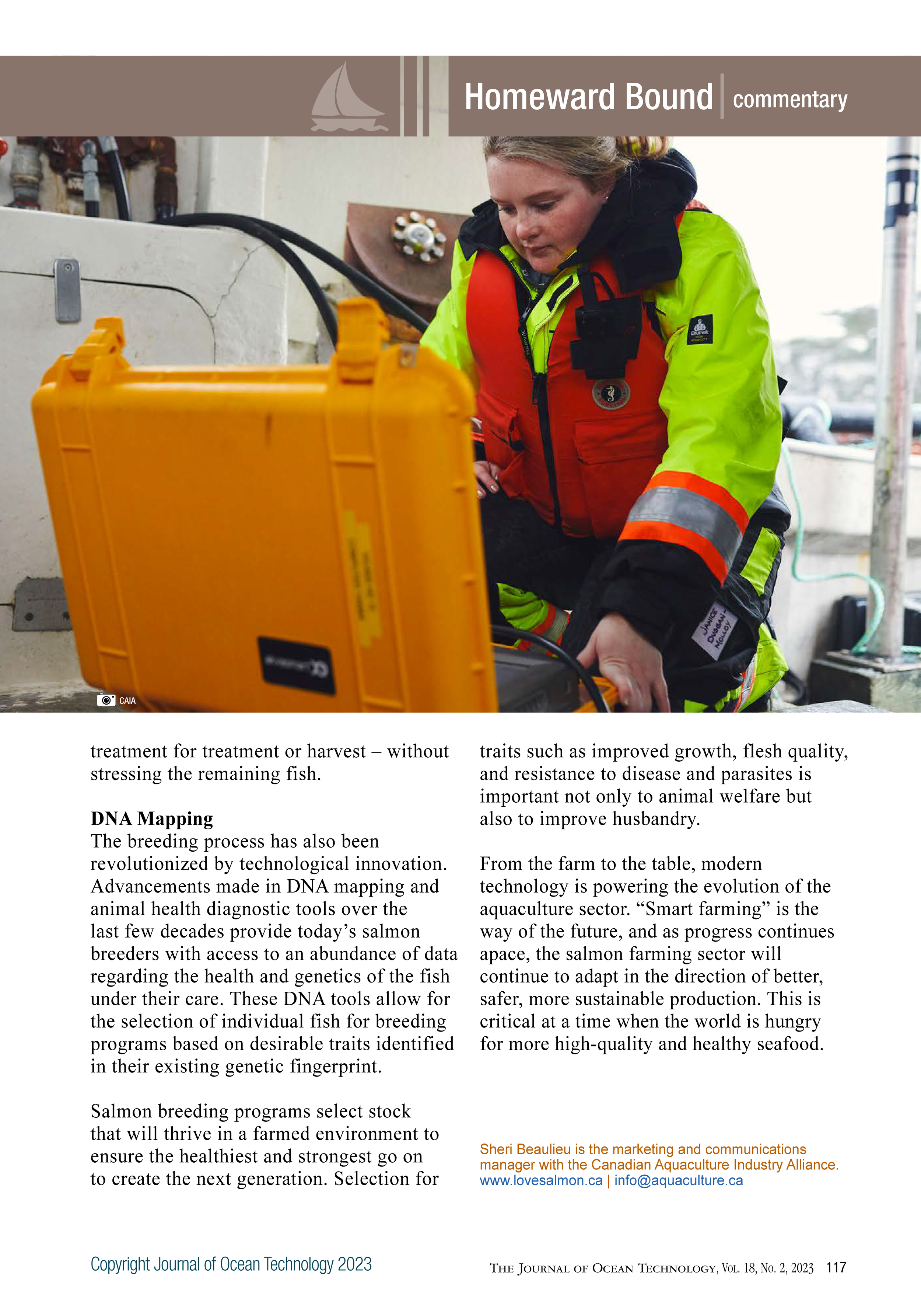Republished from The Journal of Ocean Technology, Vol. 18, No. 2, 2023. Read the original article here.
CONTRIBUTED TO THE JOURNAL OF OCEAN TECHNOLOGY BY: SHERI BEAULIEU, CANADIAN AQUACULTURE INDUSTRY ALLIANCE
The industry that puts your favourite seafood on the table is producing more food with more precision and safety than ever before. Salmon farming in Canada is led by science, featuring state-of-the-art technology to produce a healthy protein with a low-carbon footprint.
The technology is getting smarter – connected devices are improving modern fish farming and revolutionizing the way business is done. Technological solutions have vastly improved operational efficiency, which is good not only for farmers and companies, but also for the planet and for consumer safety.
These new technologies and innovations are being implemented at the hatchery, grow-out, and processing phases of the farm-raised salmon production cycle. Here are some examples of what salmon farming operations across the country are doing to improve their processes through the technology of connectivity.
Advanced Environmental Monitoring
Ocean-based farm-raised salmon containment systems are an essential part of modern farms that raise salmon in their natural environment.
Monitoring this ocean rearing environment is a key aspect of keeping the fish healthy. Changing water chemistry (dissolved oxygen and temperature) and harmful algal blooms are just some of the risks to the health and welfare of the fish.
Canada’s seafood farmers rely on management platforms that provide real-time data on ocean environmental conditions. The platforms combine a complex system of marine data visualization tools layered with numerical ocean models and statistical analysis of local waterways to provide historical, current, and future-focused models of performance; the models allow farm managers to monitor current conditions, revisit past weather or mortality events, and plan for weather-related or environmental events that may take place in the future.
The platforms unify existing sensor networks on farms to collect information and provide a clear window into how salmon farms react to changing ocean conditions using both in-pen data and publicly available data. These forecasting and mitigation technologies provide farms with the opportunity to reduce production impact of marine risks, such as harmful plankton blooms and sea lice outbreaks, as well as improve fish welfare and efficiency.
Health Monitoring
In addition to technology that captures environmental information, there is also imaging and sensors technology available to continuously survey stocks and monitor the health status of individual fish within a pen.
Sensors register fish size, number of sea lice, and possible signs of disease. Real-time data analysis increasingly enables farmers and company veterinarians to swiftly detect and respond to irregularities with the potential to divert individual fish requiring treatment for treatment or harvest – without stressing the remaining fish.
DNA Mapping
The breeding process has also been revolutionized by technological innovation. Advancements made in DNA mapping and animal health diagnostic tools over the last few decades provide today’s salmon breeders with access to an abundance of data regarding the health and genetics of the fish under their care. These DNA tools allow for the selection of individual fish for breeding programs based on desirable traits identified in their existing genetic fingerprint.
Salmon breeding programs select for stock that will thrive in a farmed environment to ensure the healthiest and strongest go on to create the next generation. Selection for traits such as improved growth, flesh quality, and resistance to disease and parasites is important not only to animal welfare but also to improve husbandry.
From the farm to the table, modern technology is powering the evolution of the aquaculture sector. “Smart farming” is the way of the future, and as progress continues apace, the salmon farming sector will continue to adapt in the direction of better, safer, more sustainable production. This is critical at a time when the world is hungry for more high-quality and healthy seafood.


